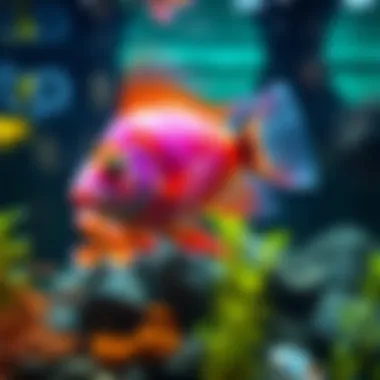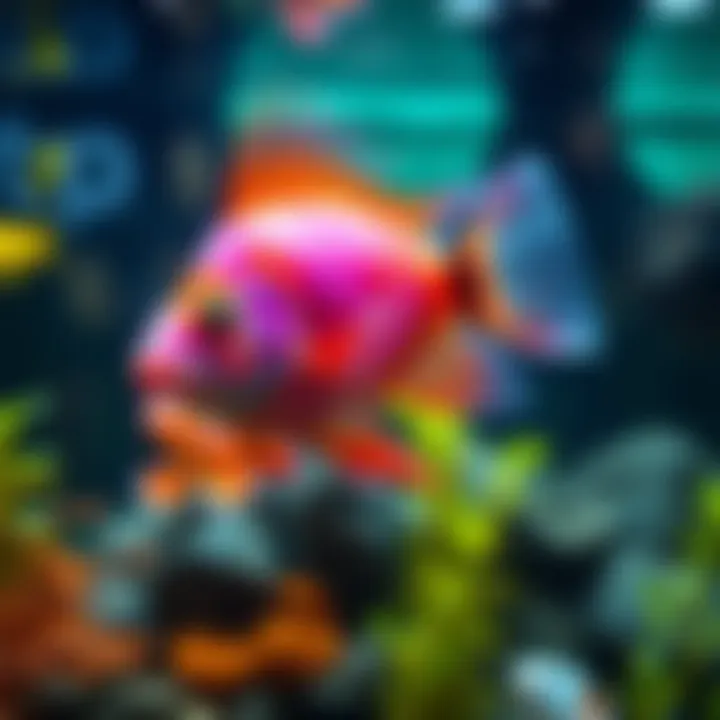Comprehensive Guide to the 29-Gallon Aquarium Tank


Intro
In the fascinating realm of aquarium setups, the 29-gallon tank often stands out as a favored choice. It serves as a bridge between those just starting their aquatic journey and seasoned aquarists seeking a versatile environment. This tank offers ample space for various species while still being manageable for maintenance. As we explore the ins and outs of this tank size, we will uncover its significance, spanning from selecting the right aquatic life to the nitty-gritty of keeping it pristine.
Embarking on this journey requires an understanding of why a 29-gallon tank can be an optimal selection. The size itself strikes a balance, providing enough room for colorful inhabitants while not overwhelming a beginner. Besides, it presents plenty of opportunities for planting and ornamentation, adding depth and beauty to the aquatic landscape.
In the following sections, various critical aspects of the 29-gallon aquarium will be detailed, focusing on design elements, species compatibility, and maintenance practices. This isn't just about keeping fish; it’s about creating a thriving environment that mimics natural ecosystems as closely as possible.
Let’s dive deeper!
Animal Species Profile
Prelude to the Animal Species
When considering a 29-gallon aquarium, choosing the right species is essential. Popular species like Betta fish, tetras, guppies, and corydoras catfish are often noted for their adaptability. These fish vary not just in size but also in personality and compatibility. The joy of having a community tank where diverse species coexist involves understanding their unique needs and interactions.
Physical Characteristics and Appearance
Imagine a vibrant collection of fish swimming through a lushly planted environment. Betta fish, known for their brilliant colors and flowing fins, can be a centerpiece. On the other hand, neon tetras add dots of blue and red to the scene, while the peaceful corydoras scavenge along the substrate. Each species adds its own flair, contributing to a visually appealing aquarium.
Natural Habitat and Distribution
Most freshwater fish thrive in specific conditions. For example, the Betta originates from the rice paddies of Southeast Asia, preferring warm, shallow waters. In contrast, neon tetras hail from the Amazon Basin. Their preferences for temperature and water quality should guide how you set up their environment. Ensuring these conditions closely mimic their natural habitat is crucial for their health and wellbeing.
Behavior and Social Interactions
The social dynamics of your aquarium can be as intriguing as their physical beauty. Bettas can be territorial, especially during breeding, while guppies tend to be more social and thrive in groups. Understanding these interactions helps in preventing conflicts and maintaining a peaceful community. A well-planned tank layout with hiding spaces can further reduce stress and promote harmony.
Conservation & Wildlife Efforts
Overview of Conservation Status
Many fish species kept in home aquariums face threats in the wild due to habitat destruction and overfishing. Understanding the conservation status of your chosen species is pivotal. Organizations like the World Wildlife Fund (WWF) focus on protecting aquatic ecosystems.
Threats to the Species
Fish face numerous challenges; pollution, invasive species, and climate change can devastate populations. For instance, the decline in water quality in the Amazon affects neon tetra populations significantly. When keeping fish, consider the impacts of the broader ecological landscape on their sustainability.
Conservation Initiatives and Organizations
Conservation initiatives play a vital role in protecting our aquatic friends. Aquarium conservation programs aim to educate hobbyists about ethical sourcing and responsible pet ownership. Resources such as the Center for Aquatic Conservation (CAC) delve deeper into these initiatives.
Success Stories and Impact
There are instances where community efforts have rejuvenated fish populations. Programs aimed at restoring habitats in the Amazon River system have seen positive results. Learning about these stories fosters a greater appreciation for the ecosystems supporting our pets.
Animal Behavior & Psychology
Communication and Language Cues
Fish communicate not through vocal sounds but through behaviors. Betta fish often flare their fins and change color as a form of display. Observing these interactions can provide insight into their mood and health.
Reproductive Behavior and Parenting
Fish reproductive behaviors vary greatly. For example, Bettas build bubble nests and exhibit courtship dances, while some tetras are egg scatterers. Understanding these behaviors enhances appreciation of the species you keep and guides successful breeding efforts in your tank.
Cognitive Abilities and Problem-Solving Skills
Surprisingly, some fish have shown remarkable learning abilities. Studies suggest that fish can navigate mazes and respond to challenges, indicating a degree of intelligence that often goes unrecognized. Recognizing these traits can deepen the connection between you and your aquatic companions.
Emotional Intelligence and Social Dynamics
Research into fish emotions suggests they can experience stress and feelings similar to higher mammals. Observing how they interact within your tank can reveal how they cope with changes in their environment.
Unique Facts & Trivia
Little-known Facts About the Animal
Did you know that neon tetras can signal danger to one another by rapidly swimming back and forth? Or that Betta fish can breathe air? These are fascinating nuances that make them more than just colorful decorations in your living space.
Surprising Behaviors or Adaptations
Certain species, like the corydoras catfish, have a unique adaptation of growing bony plates on their bodies to protect from predators. Remarkable adaptations such as these enhance their survival, making them intriguing candidates for any aquarium.
Fun Trivia and Quirky Behaviors
Guppies are notorious for their breeding capabilities, often producing multiple fry in a month. They are fascinating to watch as their reproductive behavior unfolds, making them a delightful addition to your tank.
Record-breaking Feats or Abilities
Some species exhibit incredible abilities, such as the longest living freshwater fish—the koi, known to live over 200 years. These facts reveal just how diverse and resilient aquatic life can be.


Pet Care & Tips
Choosing the Right Pet for Your Lifestyle
Before diving headfirst into fishkeeping, reflect on your lifestyle. Regular maintenance, feeding schedules, and understanding the needs of your species will shape your experience. It’s crucial to align your pet choices with your time and resources.
Basic Care Requirements and Habitat Setup
Creating the ideal environment involves selecting appropriate substrates, plants, and decorations. Always prioritize filtration and temperature control, as they are the backbone of any healthy aquarium.
Health and Wellness Tips for Pet Longevity
Regular monitoring for signs of stress or illness can be the difference between a thriving aquarium and a failing one. Conduct periodic water tests and maintain a proper feeding regimen to keep fish healthy.
Training Techniques and Behavioral Enrichment Ideas
Providing enrichment is essential. Simple things like adding floating plants can help fish feel secure. Understanding their behaviors allows you to create a more engaging habitat for your aquatic friends.
Prologue to the 29-Gallon Aquarium
The concept of keeping aquariums dates back centuries, and as such, the 29-gallon tank has carved out a special niche in the hearts of fishkeeping enthusiasts. This size strikes a balance that appeals to both beginners and experienced aquarists alike. It’s large enough to house a variety of aquatic species, yet small enough for those who won’t be able to dedicate an entire room to fishkeeping. Having the right aquarium setup can yield a satisfying and rewarding hobby, and the 29-gallon tank offers just that.
Historical Context of Aquarium Use
Aquariums, as a practice of housing aquatic life, have roots that reach back to the ancient Roman and Chinese cultures. The earliest records show that fish were kept in ornamental ponds, symbolizing wealth and status. However, the modern aquarium as we know it began to gain traction in the mid-19th century, thanks to innovations in glass production and filtration technologies. The public was captivated by the exotic fish and the picturesque aquatic landscapes, setting off a trend that remains strong today. Over the decades, various sizes of aquariums have come into vogue, and the 29-gallon tank emerged as a reliable choice for home setups.
The implications of this historical context are noteworthy. An aquarium is not just a tank; it's a living ecosystem. When setting up a 29-gallon tank, one draws from a long tradition of aquatic husbandry. Knowledge of water chemistry, species compatibility, and proper maintenance practices is essential. As fishkeepers embrace these lessons from history, they not only keep fish but also participate in a community deeply rooted in respect for aquatic life.
Growth in Popularity of Home Aquariums
The rise of home aquariums can largely be attributed to the growing trend of indoor gardening and sustainable living practices. Just as houseplants have taken center stage in home decor, aquariums have become popular visual art pieces. As many have adopted remote working lifestyles, personal spaces are transformed into little retreats, with 29-gallon tanks often becoming the centerpiece of these sanctuaries.
In addition, social media platforms have played a pivotal role in this boom. Fishkeeping communities on sites like Reddit and Facebook foster camaraderie and exchange of ideas, from setup tips to species recommendations. It’s not just about keeping fish anymore – it’s about showcasing one's aquarium as a living canvas. Consequently, resources for these fishkeeping aficionados have flourished, making learning more accessible than ever before. With countless fellow enthusiasts to turn to, knowledge-sharing has never been easier, making the prospect of maintaining a 29-gallon tank less daunting.
To sum it up, the 29-gallon aquarium represents an ideal blend of history, community engagement, and personal passion. This size encourages fishkeeping as not just a hobby, but a lifestyle. As we will explore in the following sections, the potential within this tank is vast, accommodating various aquatic species while also demanding a dedication to maintenance and aesthetics.
Specifications and Dimensions
The specifications and dimensions of a 29-gallon tank hold significant weight in the realm of aquarium setup. This section delves into various aspects that not only shape your aquatic environment but also determine its success. Understanding these specifications helps in creating a well-balanced ecosystem that benefits both the fish and the plants involved. Moreover, being informed about dimensions, materials, and weight not only aids in selection but also in the long-term maintenance of the aquarium.
Physical Dimensions
The physical dimensions of a 29-gallon tank usually measure about 30 inches in length, 12 inches in width, and 18 inches in height. This size strikes a balance, providing ample space for fish to swim around while being compact enough for various settings, whether it's a cozy corner in your living room or a workspace desk.
Benefits of appropriate dimensions include:
- Enhanced swimming space: Fish thrive on movement. A broader surface area allows for diverse species, giving them room to maneuver.
- Easier filtration: A wider tank can accommodate a more efficient filtration system. This ensures that the water stays clear and healthy for all aquatic life.
- Stability of water parameters: A larger volume of water tends to stabilize temperature and chemical levels more effectively, creating a favorable environment for the inhabitants.
Material Composition
When selecting an aquarium, the material composition plays a crucial role in durability and aesthetics. Most 29-gallon tanks are made from either glass or acrylic, each with its unique attributes. Glass tanks tend to be heavier but resistant to scratching, providing a clear view of underwater life. On the other hand, acrylic tanks are lighter, offer better insulation, but may require careful handling to avoid scratches.
Considerations in material choice include:
- Weight: If you're setting up in a location like a high shelf, glass can be excessively heavy; acrylic would be a more suitable option.
- Maintenance needs: Glass may require more intensive cleaning to keep transparent, whereas acrylic may involve special cleaners to prevent clouding.
- Long-term appearance: Acrylic can yellow over time if not properly cared for, while glass maintains clarity longer when cleaned regularly.
Weight Considerations
With water weighing around 8.34 pounds per gallon, a filled 29-gallon tank weighs approximately 242 pounds. This significant weight means that selecting the appropriate furniture or stand to support the aquarium is vital. Ignoring weight capacity can lead to damage or accidents.
Tips for handling weight considerations:
- Choose a sturdy stand: Ensure that the stand is rated for more than 300 pounds to accommodate the tank, decorations, and water changes.
- Consider the flooring: Before setting up, assess the structural integrity of your floor. A concrete base or reinforced flooring may be necessary to support heavy setups.
- Plan for maintenance: Understanding the weight helps in planning the setup and ongoing maintenance. Lifting water for changes can be a heavy undertaking, and smart planning goes a long way in simplifying this task.
Aquatic Life Compatibility
Understanding the compatibility of aquatic life in a 29-gallon tank is pivotal for creating a thriving aquatic ecosystem. Properly pairing species enhances the chances of a harmonious environment where fish and invertebrates not only survive but also flourish. The significance of this section lies in discussing specific elements that influence compatibility, the benefits of careful selection, and considerations to keep in mind when introducing aquatic life into your tank.
Freshwater Fish Options
When it comes to freshwater fish, the 29-gallon tank presents a versatile playground. Some well-known species can make themselves at home, while others might not fare so well together. This is partly due to variations in temperament, size, and dietary needs.
Consider popular species like the Betta fish, which, despite their vibrant colors, have a somewhat aggressive demeanor, especially towards other Bettas. However, when carefully introduced to tank mates, they can live alongside quieter companions like Neon Tetras or Corydoras Catfish.
Here’s a selection of recommended freshwater fish suitable for a 29-gallon tank:
- Guppies - Hardy little creatures, great for beginners.
- Platies - Peaceful and colorful.
- Danios - Active swimmers that thrive in groups.
- Barbs - Like Tiger Barbs can be feisty but are best kept with similar energetic fish.
In major terms, it’s vital to assess not just the appearance or charm of a fish but also its inherent behavior and requirements to avoid potential conflicts.
Selecting Marine Species


Diving into marine fish species tends to involve more nuanced considerations. Unlike freshwater species, marine fish can exhibit more complex interactions due to their territorial instincts and environmental needs. A 29-gallon tank can house various beautiful reef-safe species when planned carefully.
You might consider species like:
- Clownfish - These are robust and a good fit for hobbyists dipping their toes into marine aquariums.
- Royal Gramma - Their vibrant colors and gentle nature make them a popular choice.
- Zebra Damsels - Hardy and easy to care for, these can adapt well to different community tanks.
Caution is advised when mixing marine species, as some may prove more aggressive, particularly during feeding times or in confined spaces. It’s also essential to check the needs of each species in terms of water parameters and diets, ensuring you are not setting yourself up for a tumultuous tank dynamic.
Invertebrate Considerations
Invertebrates, ranging from shrimps to snails, add character and depth to your aquarium while serving crucial functions, like algae control. However, their compatibility with fish must be examined closely. For instance, some fish might see shrimps as a tasty snack, while others will largely ignore them.
If you opt for invertebrates, consider these popular choices for a 29-gallon tank:
- Cherry Shrimp - Hardy little scavengers that can thrive with many community fish.
- Nerite Snails - These snails not only combat algae but are also delightful to observe.
- Cleaner Shrimp - Useful for keeping the tank clean; however, pairing with more aggressive fish types can be risky.
Integrating invertebrates requires a careful assessment of the tank's overall ecosystem. By selecting species that complement each other, you can create a dynamic and aesthetically pleasing environment.
In summary, understanding aquatic life compatibility in a 29-gallon tank is a balancing act that speaks to the heart of successful fishkeeping. Taking the time to analyze temperaments, dietary needs, and environmental factors results in a harmonious aquatic world that is a source of joy and tranquility.
For more information on fish compatibility and aquatic life, you may find useful insights at Wikipedia or delve deeper into specifics on Britannica.
Setting Up the Tank
Setting up the tank is not just a prerequisite for fishkeeping; it is the foundation upon which the health and happiness of your aquatic environment rests. For a 29-gallon tank, in particular, the setup plays a critical role in ensuring stability for both water conditions and the overall ecosystem. Getting this right can save you from headaches down the line, like combating algae outbreaks or dealing with fish that are stressed due to suboptimal habitats.
One common misstep among new aquarists is underestimating how critical equipment selection, substrate choice, and effective tank design are. Each of these elements contributes uniquely to the aquarium’s atmosphere, influencing not only aesthetic appeal but also the well-being of its inhabitants. Think of setting up a system as giving your fish a home that mirrors their natural habitat—if you don't provide the right conditions, they won't thrive, and the joy of fishkeeping can quickly unravel.
Essential Equipment Needed
To kick off the journey of establishing a successful tank, you’ll need to gather a few essential pieces of equipment. Here’s a rundown:
- Filter: This is crucial for maintaining water quality by removing waste and toxins. A good filter will circulate and aerate the water, promoting a healthy environment.
- Heater: Particularly if you plan to keep tropical fish, maintaining a stable temperature is vital. A high-quality heater can prevent fluctuations that might stress your fish.
- Lighting: A suitable lighting system enhances the appearance of the tank and supports plant growth, should you choose to include live plants.
- Testing Kits: Invest in kits for pH, ammonia, nitrite, and nitrate levels. These are essential for monitoring the health of your tank.
Each item plays a pivotal role in not only keeping your fish alive but ensuring they can flourish in their new home. Make sure to choose equipment corresponding to the specific needs of your chosen species.
Proper Substrate Types
When it comes to choosing substrate, it’s akin to picking the flooring in your living room. You want it to be not just attractive but functional. Depending on the types of fish and plants you aim to keep, your substrate choice will vary:
- Gravel: Often the go-to for most freshwater setups. It allows good water flow while providing a home for beneficial bacteria, enhancing tank cycling.
- Sand: Ideal for species that like to burrow. Sand provides a soft bed for bottom feeders and helps mimic conditions of natural habitats.
- Specialized Substrates: For planted tanks, consider products designed specifically to promote growth. Nutrient-rich substrates can encourage robust plant development, offering fish natural hiding places.
Ultimately, the right substrate can drastically transform the look and function of your tank, supporting both aquatic life and the overall aesthetic.
Aquascaping Techniques
Aquascaping isn't just an afterthought; it's an art form and critical for creating a thriving ecosystem. Think of it as designing a landscape underwater. Here are a few techniques to consider:
- Rule of Thirds: Divide your tank into thirds, placing focal points at the intersections. This method creates balance and visual interest.
- Layering: Utilize various heights; tall plants or decorations at the back, mid-sized in the middle, and shorter ones in the front create a natural look.
- Natural Dispersal: Incorporate driftwood or rocks to mimic natural habitats. The areas these natural elements create will serve as hiding spots and breeding grounds for certain species.
In this domain, less is often more. Avoid overcrowding your tank; giving fish ample space will reduce stress and allow them to exhibit natural behaviors.
In summary, being deliberate with your setup can create harmony in your aquatic environment. Focus on quality equipment, suitable substrate, and thoughtful aquascaping; they’re the pillars of a healthy and beautiful 29-gallon setup, laying the groundwork for an enjoyable fishkeeping experience.
Maintenance Practices
Maintaining a 29-gallon aquarium might seem like a daunting task at first, but it's crucial for ensuring not just the aesthetics but the health of your aquatic inhabitants. The right maintenance practices can mean the difference between a thriving underwater ecosystem and a struggling one. This section will explore the fundamental elements of aquarium maintenance and the benefits each brings to your aquatic environment.
Water Quality Management
Water quality is the backbone of any successful aquarium. Factors such as pH, ammonia levels, nitrites, and nitrates play a significant role in the well-being of fish and plants. Here are some key practices to maintain optimal water quality:
- Testing Equipment: Using kits such as API Freshwater Master Test Kit can provide you with accurate readings of your water parameters. Regular testing, ideally once a week, helps catch issues before they escalate.
- Water Changes: Changing 10-20% of the tank water weekly keeps toxins in check and replenishes essential minerals. It’s like giving your fish a breath of fresh air.
- Filtration: A good filter is your best friend. Ensure your filter is adequately rated for a 29-gallon tank to provide adequate circulation and filtration. Note, a canister filter for stability can serve you well.
- Dechlorination: If you’re using tap water, always treat it with a dechlorinator to remove harmful chemicals from the water.
- Temperature Regulation: Keeping the water at an appropriate temperature is vital. Use a reliable heater with a temperature controller to avoid drastic fluctuations.
Regular tracking of these parameters will help you spot trends and prevent many issues before they arise. Proper water management not only ensures the health of your fish but also supports plant growth, fostering a lush environment.
Regular Cleaning Routines
Cleaning routines might sound like a chore, but they’re essential for keeping your aquarium healthy. Maintaining a clean tank reduces the build-up of waste and prevents algae bloom. Here's how you can go about it:
- Substrate Vacuuming: Use a gravel siphon during water changes to remove waste and uneaten food from the substrate. This keeps bacteria from accumulating in your tank.
- Glass Cleaning: Algae can quickly become a nuisance. A soft scrubbing pad designed for aquariums can effectively remove algae without scratching glass or acrylic. Regularly scheduled cleanings could help avoid excessive algae that might lead to unsightly views.
- Filter Maintenance: Cleaning or replacing filter media periodically is necessary to maintain water flow. Just ensure you rinse it in tank water, not tap water, to preserve beneficial bacteria vital for water cycling.
- Decor and Equipment: Regularly inspect decorations, plants, and equipment for algae or residue, and clean them as necessary. “Out of sight, out of mind” might work for most things but certainly not for aquariums!
Routine cleaning helps reduce stress on your fish and contributes to a stable environment conducive to both the inhabitants and their aesthetics.
Monitoring Fish Health
Fish are not only beautiful to observe; they're also indicators of the health of your aquarium environment. Monitoring their behavior and well-being is paramount:
- Daily Observations: Look for changes in swimming patterns, eating habits, and social interactions. Fish that isolate themselves or show signs of distress may need immediate attention.
- Signs of Illness: Watch for clamped fins, unusual swimming, or discoloration. Diseases such as ich or fin rot, if caught early, can often be treated effectively.
- Stress Factors: Water quality, tank mates, and the environment can affect fish health. Regular checks on these factors will help in managing any stress your little finned friends may encounter.
- Professional Advice: Don't hesitate to consult local fish stores or online forums for insights on fish behavior and care. Utilizing platforms like reddit.com can connect you with an enthusiastic community that shares their experiences.
Monitoring fish health routinely ensures you maintain a vibrant ecosystem where all species can thrive. Bringing together water quality, regular maintenance, and health checks encapsulates a holistic approach to tank care that can keep your 29-gallon aquarium in prime condition.


Benefits of a 29-Gallon Tank
The 29-gallon aquarium tank stands out among various sizes for a number of compelling advantages. It strikes an appealing balance, offering beginners and seasoned aquarists alike a manageable yet versatile option for aquatic life. Understanding these benefits can significantly impact the choice of tank and its subsequent setup and maintenance, making it crucial to consider before diving into fishkeeping.
Ideal Size for Beginners
One of the most notable advantages of the 29-gallon tank is its optimal size for newcomers to fishkeeping. Many first-time aquarists find smaller tanks challenging due to rapid changes in water conditions, which can often lead to stress or even fatalities among fish.
A 29-gallon tank provides sufficient volume to maintain stable water parameters. The larger water volume acts like a buffer, reducing the rate of fluctuations in temperature and chemical balance, which is particularly helpful for newcomers who are still getting the hang of things.
Another point worth mentioning is that a tank of this size allows for a greater variety of fish species, enabling beginners to experiment and learn. They can begin with hardier species and slowly progress to more delicate types as their confidence grows. It’s like learning to ride a bike with training wheels–you still get good practice but with a safety net.
Versatility in Aquatic Life
The 29-gallon tank shines in its versatility when it comes to aquatic life. Unlike smaller tanks that limit fish options, this medium-sized tank can accommodate a diverse array of freshwater and marine species.
For freshwater setups, popular choices include:
- Tetras
- Cichlids
- Rasboras
- Guppies
Switching to a saltwater environment? No problem. You can opt for vibrant clownfish, gobies, or even some invertebrates like shrimps to jazz up the display. This versatility allows aquarists to craft their own unique underwater ecosystem, introducing layers of complexity influenced by the chosen species. In a sense, setting up a 29-gallon aquarium can be akin to being a conductor in an orchestra, harmonizing various elements to create a beautiful aquatic symphony.
Aesthetic Appeal and Space Efficiency
The 29-gallon tank also excels in aesthetic appeal while being space-efficient. Its dimensions make it easy to find a suitable location in homes or offices without taking up excessive space. The sight of a well-planted and maintained tank can be mesmerizing, serving as both a natural artwork and a calming element in any room.
Furthermore, these tanks are surprisingly easy to decorate and aquascape. With ample depth and height for creative layouts, hobbyists can incorporate plants, rocks, and driftwood to create visually stunning environments.
In summary, whether you are placing it in a cozy corner of your living room or a professional space, the 29-gallon aquarium can serve as a striking focal point, enhancing your environment's overall décor and ambiance.
"The right aquarium can bring life to a dull room and tranquility to a restless mind."
In essence, a 29-gallon tank is not just a container; it can be a vibrant community filled with life and beauty, rewarding the effort of care and focus placed upon it. As you embark on this aquatic journey, recognizing the strengths of this tank can help you in creating a flourishing habitat for your aquatic companions.
Common Challenges
Navigating the world of aquatic life in a 29-gallon tank presents both rewards and hurdles. While many rejoice at the dual advantages of beauty and tranquility that a well-maintained aquarium can offer, a fishkeeper must also grapple with challenges that can impact their aquatic ecosystem. Understanding these obstacles is crucial for ensuring a thriving habitat for both flora and fauna. Here, we will discuss common challenges that arise in this setup, which can greatly affect the health of the fish and plants within.
Algae Growth Issues
Algae growth is a common challenge that many aquarium enthusiasts face. It's almost inevitable at some point, like death and taxes. While a small amount of algae can be harmless, excessive growth can lead to several problems. The green film covering the tank sides can mar the aesthetic appeal while blocking light necessary for photosynthesis in aquatic plants. Moreover, algae blooms can deplete oxygen levels, which is dangerous for fish.
Some tips to manage algae growth include:
- Regular Cleaning: Set aside time for routine scrub downs of the tank's surfaces and decorations.
- Controlling Light Exposure: Limit the number of hours the tank's light is on. Algae feast on light, so reducing this exposure can help keep growth in check.
- Introducing Algae-Eating Species: Fish like otocinclus or certain snails can naturally help regulate algae levels.
In summary, while algae growth may be a pain in the neck, it can be managed with consistent care and an understanding of the causes behind it.
Fish Aggression and Compatibility
Another hurdle to climb is ensuring that the fish cohabitate harmoniously. Not every fish gets along with its neighbors; you’ve got to tread lightly. Fish aggression can disrupt the peace in your tank, leading to stress or even injury among the fish. It is essential to do your homework on species compatibility before making introductions.
To minimize aggression:
- Research Species: Some species are more territorial than others. For example, cichlids can be quite confrontational and might cause trouble in a mixed-community setting.
- Aquarium Size Considerations: Even in a 29-gallon tank, overcrowding can create stress, so it’s important to adhere to recommended stocking levels.
- Introduce at Once: Adding a group of fish at the same time rather than one at a time can help distribute territory disputes more evenly.
Navigating potential aggressors among your aquatic residents is an essential part of creating a balanced ecosystem that remains serene, devoid of those pesky power struggles.
Disease Management
Disease is an unfortunate aspect of managing any aquarium. Just when you think everything is swimming along smoothly, a fish can fall ill and disrupt the whole balance. Conditions like ich, fin rot, and dropsy, to name a few, can arise due to stress, poor water quality, or even new introductions to the tank. Knowledge of preventive measures and treatment options becomes vital when tackling these issues.
Considerations for effective disease management include:
- Routine Monitoring: Check fish behavior regularly and look for signs of illness such as lethargy or abnormal swimming patterns. Early detection usually makes a massive difference.
- Quality Water: Focus on maintaining high water quality through proper filtration and regular water changes. Testing kits can help keep track of ammonia, nitrite, and nitrate levels.
- Quarantine New Additions: Before introducing any new fish or plants, quarantine them for a few weeks to ensure they don’t carry diseases into the established tank.
By proactively managing disease, one can ensure that the aquarium remains a vibrant habitat, fostering the beautiful, serene atmosphere that many seek in a 29-gallon aquarium.
End
The conclusion of this article reinforces the importance of understanding the 29-gallon aquarium tank. A properly set up tank provides a viable ecosystem that supports diverse aquatic life, while also catering to the needs of both novice and experienced fishkeepers. This section serves as the crux, tying together various aspects discussed throughout the article—ranging from specifications to compatibility. Each segment emphasizes how intricately woven the components of fishkeeping are in ensuring a thriving environment.
Recap of Key Insights
A few essential points recap the journey of setting up a 29-gallon aquarium:
- Size and Specification: The 29-gallon tank strikes a balance between space and manageability. It is large enough to accommodate a variety of species, but not so big that it becomes overwhelming to maintain.
- Species Compatibility: Freshwater and marine options abound, yet choosing the right pairing is crucial. Select fish and invertebrates that are not only compatible but also thrive in a shared environment.
- Maintenance Practices: Keeping water quality stable and performing regular maintenance are vital. Understanding routines can prevent pitfalls like overgrowth and disease, ensuring all inhabitants are in peak health.
Effectively, knowing all these aspects can transform the 29-gallon tank from a simple containment vessel into a robust aquatic habitat.
Encouragement for Potential Fishkeepers
For those considering stepping into the world of aquarium keeping, the 29-gallon tank represents a sensational choice. It's manageable enough for first-timers yet complex enough to engage seasoned hobbyists. Embracing this hobby can be rewarding, offering a beautiful and peaceful slice of nature in your living space.
It's not just about adding fish to water; it’s about creating an environment where every organism plays a role. Don’t hesitate to dive in! Start small, educate yourself continuously, and remember, every seasoned aquarist was once a beginner. Success in the realm of fishkeeping is not only attainable but comes with immense satisfaction and joy.
“An aquarium set with care is a symphony of life.”
As you set foot on this aquatic adventure, embrace both the challenges and the rewards. By understanding the intricacies and committing fully to your aquarium's upkeep, you can ensure a healthy and vibrant environment for aquatic life and a delightful experience for yourself.







